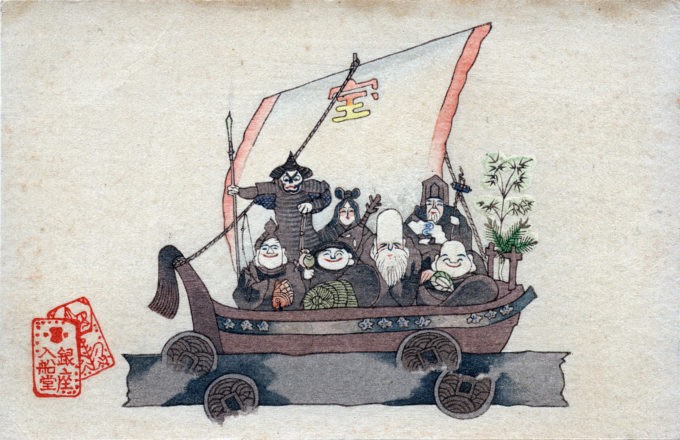
Seven Gods of Luck and Good Fortune, c. 1920.
Back row, left to right: Benzaiten (Goddess of Arts & Knowledge), Fukurokuju (God of Wealth, Happiness, and Longevity), Jurōjin (God of Wisdom), Bishamonten (God of Warriors, Lord of Wealth and Treasure, and guardian of the places where the Buddha preaches).
Front row, left to right: Hotei (God of Happiness and Abundance), Ebisu (God of Fishing, Shipping & Commerce), and Daikokuten (God of Wealth and Prosperity).
See also:
Enoshima, c. 1910-1960.
Hachiman Temple, Kamakura, c. 1910.
“The ‘Seven Lucky Gods of Japan’ deities are a group of deities whose origins stem from Indian, Chinese, and indigenous Japanese gods of fortune. Not all of the gods are mythical beings. One of them is an actual historical person.
“Each of the seven gods is recognized as a deity for more than a thousand years and each has had its own large following of believers. Gradually, however, these gods were transformed from remote and impersonal deities to warmer and more benevolent teleological patrons of those professions, arts, and skills practices by the Japanese.
“… During the early years of the gods’ existence in Japan, it is assumed that the first earnest believers of the Seven Lucky Gods were merchants, and that the first two gods of the seven to gain popularity were Daikoku and Ebisu, for those were the gods of business. Other classes of Japanese society began to look amongst the pantheon of gods to see if among them there wasn’t one who was suitable for their endeavors.
“Before long, the goddess Benten became the accepted patron of the arts. Fukurokuju and Jurojin as well as Hotei were Chinese imports who were gods and sages. The first two, Fukurokuju and Jurojin, began to have their following amongst the intellectual classes and the latter, Hotei, began to occupy a unique position among the gods*. Bishamon was looked to by travelers, doctors, and missionaries.
“In the beginning each of the gods was worshiped separately, but now a days this is rarely so … Perhaps one reason for this group worship is that the number seven is sacred to the Japanese. Another reason, and this one is psychological, is that the Japanese people are fond of groups.”
– The Seven Lucky Gods of Japan, by Reiko Chiba, 1966

Seven Lucky Gods of Japan, c. 1930. Left-to-right: Ebisu (God of Fishing, Shipping & Commerce), Bishamoten (God of Warriors, Lord of Wealth and Treasure, and guardian of the places where the Buddha preaches), Hotei (God of Happiness and Abundance), Benzaiten (Goddess of Arts & Knowledge), Fukurokuju (God of Wealth, Happiness, and Longevity), Jurōjin (God of Wisdom), Daikokuten (God of Wealth and Prosperity).

